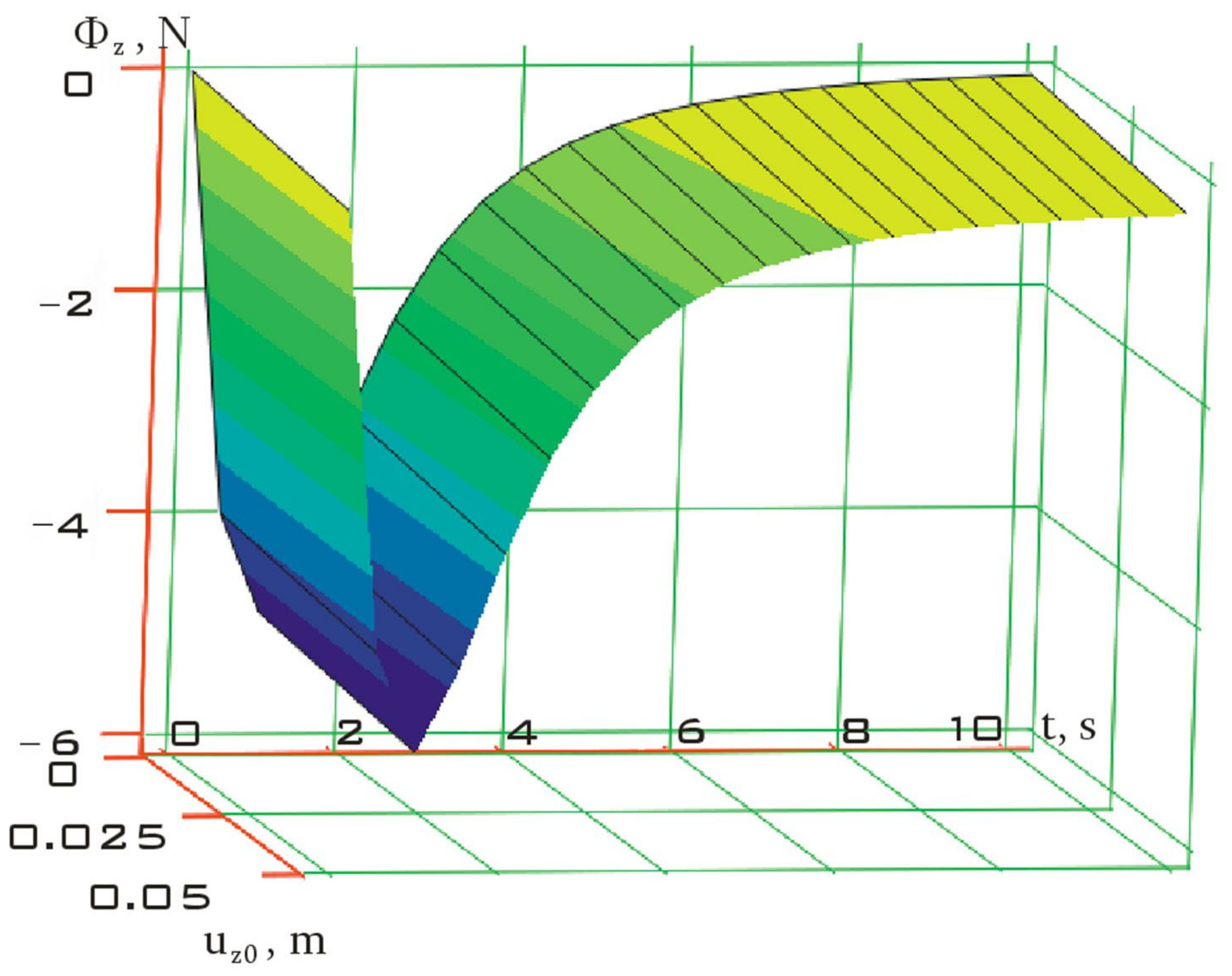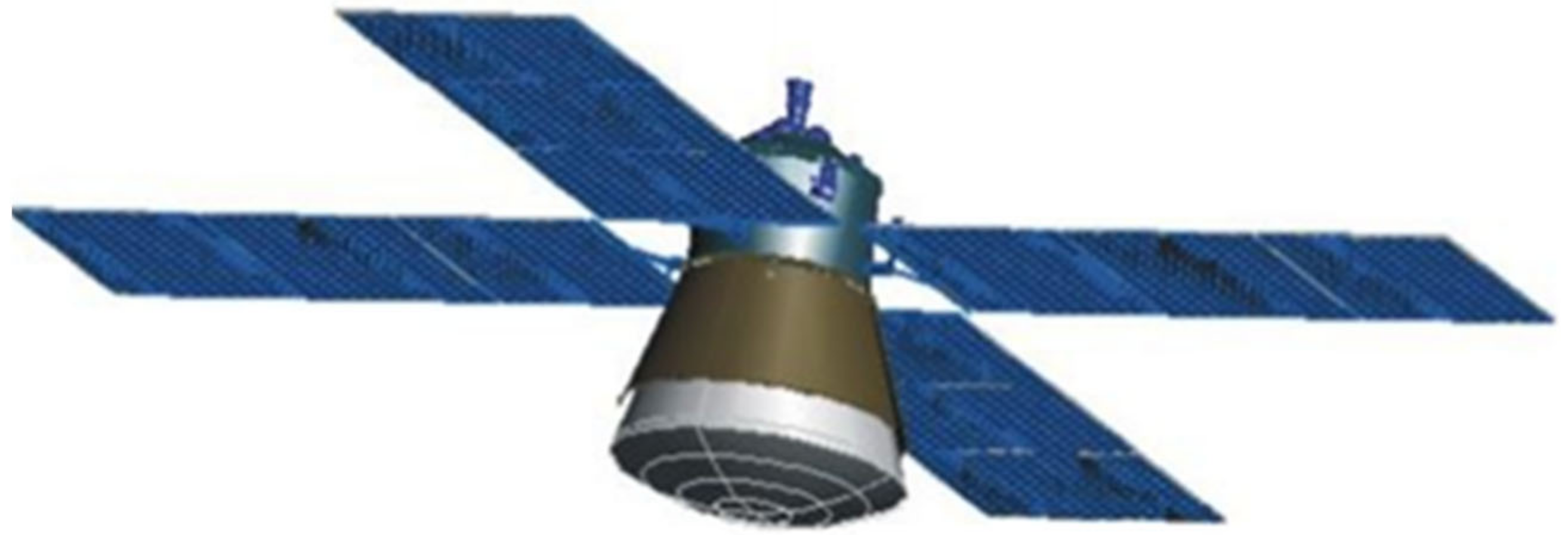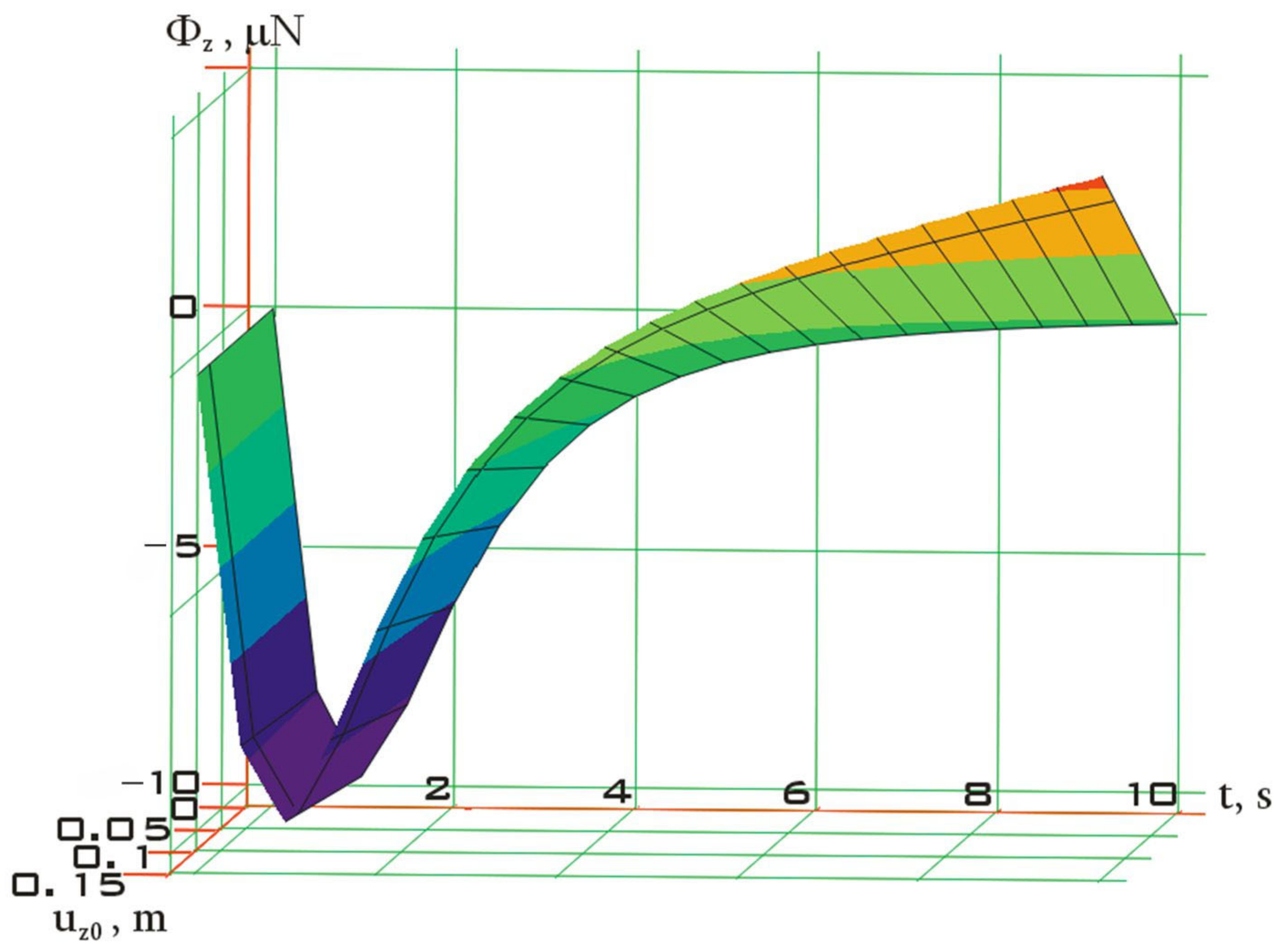Investigation of Perturbations Arising from Temperature Shock with a Symmetrical Arrangement of Flexible Elements of a Small Spacecraft
Abstract
1. Introduction
2. The Problem of Thermoelasticity
3. Evaluation of Disturbing Factors
4. Numerical Modeling
5. Conclusions
Author Contributions
Funding
Institutional Review Board Statement
Informed Consent Statement
Data Availability Statement
Acknowledgments
Conflicts of Interest
References
- Ovchinnikov, M.Y.; Guerman, A.D.; Mashtakov, Y.V.; Roldugin, D.S. Mathematical Modeling of the Dynamics of a Low-Flying Spacecraft with a Ramjet Electric Propulsion Engine. Math. Model. Comput. Simul. 2022, 14, 452–465. [Google Scholar] [CrossRef]
- Makarov, S.B.; Liu, M.; Ovsyannikova, A.S.; Zavjalov, S.V.; Lavrenyuk, I.; Xue, W.; Xu, Y. A Reduction of Peak-to-Average Power Ratio Based Faster-Than-Nyquist Quadrature Signals for Satellite Communication. Symmetry 2021, 13, 346. [Google Scholar] [CrossRef]
- Sedelnikov, A.; Orlov, D.; Serdakova, V.; Nikolaeva, A. The Symmetric Formulation of the Temperature Shock Problem for a Small Spacecraft with Two Elastic Elements. Symmetry 2023, 15, 172. [Google Scholar] [CrossRef]
- Taneeva, A.S. The formation of the target function in the design of a small spacecraft for technological purposes. J. Phys. Conf. Ser. 2021, 1901, 12026. [Google Scholar] [CrossRef]
- Anshakov, G.P.; Belousov, A.I.; Sedel’nikov, A.V.; Gorozhankina, A.S. Efficiency Estimation of Electrothermal Thrusters Use in the Control System of the Technological Spacecraft Motion. Russ. Aeronaut. 2018, 61, 347–354. [Google Scholar] [CrossRef]
- Anttu, N. Absorption of Light in Finite Semiconductor Nanowire Arrays and the Effect of Missing Nanowires. Symmetry 2021, 13, 1654. [Google Scholar] [CrossRef]
- Sedelnikov, A.V.; Potienko, K. Analysis of Reduction of Controllability of Spacecraft During Conducting of Active Control Over Microaccelerations. Int. Rev. Aerosp. Eng. 2017, 10, 160. [Google Scholar] [CrossRef]
- Bormotov, A.; Orlov, D.; Bratkova, M. Modeling the deformation of an elastic element of a small spacecraft in its plane during temperature shock. E3S Web Conf. 2023, 376, 1085. [Google Scholar] [CrossRef]
- Sedelnikov, A.V.; Salmin, V.V. Modeling the disturbing effect on the aist small spacecraft based on the measurements data. Sci. Rep. 2022, 12, 1300. [Google Scholar] [CrossRef]
- Taneeva, A.S.; Lukyanchik, V.V.; Khnyryova, E.S. Modeling the Dependence of the Specific Impulse on the Temperature of the Heater of an Electrothermal Micro-Motor Based on the Results of Its Tests. J. Phys. Conf. Ser. 2021, 2096, 12059. [Google Scholar] [CrossRef]
- Orlov, D.; Serdakova, V.; Evtushenko, M.; Khnyryova, E.; Nikolaeva, A. Investigating the Features of Various Plate Models Under the Thermal Shock in the ANSYS Package. In Proceedings of the XV International Scientific Conference “INTERAGROMASH 2022”, Rostov-on-Don, Russia, 25–27 May 2022; Lecture Notes in Networks and Systems 2023. Volume 574, pp. 3085–3093. [Google Scholar] [CrossRef]
- Sedelnikov, A.V. Evaluation of the level of microaccelerations on-board of a small satellite caused by a collision of a space debris particle with a solar panel. Jordan J. Mech. Ind. Eng. 2017, 11, 121–127. [Google Scholar]
- Ovchinnikov, M.Y.; Tkachev, S.S.; Shestopyorov, A.I. Mathematical Model of a Satellite with an Arbitrary Number of Flexible Appendages. Math. Model. Comput. Simul. 2021, 13, 638–647. [Google Scholar] [CrossRef]
- Ibrahim, A.; Modi, V. A formulation for studying dynamics of N connected flexible deployable members. Acta Astronaut. 1987, 16, 151–164. [Google Scholar] [CrossRef]
- Sedel’nikov, A.V. Fractal assessment of microaccelerations at weak damping of natural oscillation in spacecraft elastic elements. II. Russ. Aeronaut. 2007, 50, 322–325. [Google Scholar] [CrossRef]
- Russkikh, S.V.; Shklyurchuk, F.N. Nonlinear Oscillations of Elastic Solar Panels of a Spacecraft at Finite Turn by Roll. Mech. Solids 2018, 53, 147–155. [Google Scholar] [CrossRef]
- Kartashov, E.M. Analytical Methods of Solution of Boundary-Value Problems of Nonstationary Heat Conduction in Regions with Moving Boundaries. J. Eng. Phys. Thermophys. 2001, 74, 498–536. [Google Scholar] [CrossRef]
- Sedelnikov, A.; Serdakova, V.V.; Khnyryova, E.S. Construction of the Criterion for Using a Two-dimensional Thermal Conductivity Model to Describe the Stress–strain State of a Thin Plate Under the Thermal Shock. Microgravity Sci. Technol. 2021, 33, 65. [Google Scholar] [CrossRef]
- Shen, Z.; Tian, Q.; Liu, X.; Hu, G. Thermally induced vibrations of flexible beams using Absolute Nodal Coordinate Formulation. Aerosp. Sci. Technol. 2013, 29, 386–393. [Google Scholar] [CrossRef]
- Tarasov, D.; Konovalov, V.; Zaitsev, V.; Rodionov, Y. Mathematical modeling of the stress-strain state of flexible threads with regard to plastic deformations. J. Phys. Conf. Ser. 2018, 1084, 12008. [Google Scholar] [CrossRef]
- Tarasov, D.; Konovalov, V.; Zaitsev, V.; Rodionov, Y. Mathematical modeling of deformations of flexible threads under their dynamic loading in the zone of material plasticity. J. Phys. Conf. Ser. 2019, 1278, 12014. [Google Scholar] [CrossRef]
- Sedelnikov, A.V.; Orlov, D.I. Analysis of the Significance of the Influence of Various Components of the Disturbance from a Temperature Shock on the Level of Microaccelerations in the Internal Environment of a Small Spacecraft. Microgravity Sci. Technol. 2021, 33, 22. [Google Scholar] [CrossRef]
- Johnston, J.D.; Thornton, E.A. Thermally induced attitude dynamics of a spacecraft with a flexible appendage. J. Guid. Control Dyn. 1998, 21, 581–587. [Google Scholar] [CrossRef]
- Kirilin, A.N.; Akhmetov, R.N.; Shakhmatov, E.V.; Tkachenko, S.I.; Baklanov, A.I.; Salmin, V.V.; Semkin, N.D.; Tkachenko, I.S.; Goryachkin, O.V. Experimental Technological Small Spacecraft “Aist–2D”; Publishing House of the Samara Scientific Center of the Russian Academy of Sciences: Samara, Russia, 2017; p. 324. [Google Scholar]
- Sedelnikov, A.V.; Orlov, D.I.; Serdakova, V.V.; Nikolaeva, A.S. Investigation of the Stress-Strain State of a Rectangular Plate after a Temperature Shock. Mathematics 2023, 11, 638. [Google Scholar] [CrossRef]
- Lyubimova, T.; Rybkin, K.; Fattalov, O.; Kuchinskiy, M.; Kozlov, M. Investigation of Generation and Dynamics of Microbubbles in the Solutions of Anionic Surfactant (SDS). Microgravity Sci. Technol. 2022, 34, 74. [Google Scholar] [CrossRef]
- Wang, A.; Wang, S.; Xia, H.; Ma, G. Dynamic Modeling and Control for a Double-State Microgravity Vibration Isolation System. Microgravity Sci. Technol. 2023, 35, 9. [Google Scholar] [CrossRef]
- Anshakov, G.P.; Belousov, A.I.; Sedel’nikov, A.V. The problem of estimating microaccelerations aboard Foton-M4 spacecraft. Russ. Aeronaut. 2017, 60, 83–89. [Google Scholar] [CrossRef]
- Zhu, Q.; Jiang, W.; Zhu, Y.; Li, L. Geometric Accuracy Improvement Method for High-Resolution Optical Satellite Remote Sensing Imagery Combining Multi-Temporal SAR Imagery and GLAS Data. Remote Sens. 2020, 12, 568. [Google Scholar] [CrossRef]
- Jiang, Y.; Wang, J.; Zhang, L.; Zhang, G.; Li, X.; Wu, J. Geometric Processing and Accuracy Verification of Zhuhai-1 Hyperspectral Satellites. Remote Sens. 2019, 11, 996. [Google Scholar] [CrossRef]
- Su, Z.; Zhong, X.; Zhang, G.; Li, Y.; He, X.; Wang, Q.; Wei, Z.; He, C.; Li, D. High Sensitive Night-time Light Imaging Camera Design and In-orbit Test of Luojia1-01 Satellite. Sensors 2019, 19, 797. [Google Scholar] [CrossRef] [PubMed]
- Sedelnikov, A.V. Algorithm for restoring information of current from solar panels of a small spacecraft prototype “Aist” with help of normality conditions. J. Aeronaut. Astronaut. Aviat. 2022, 54, 67–76. [Google Scholar]
- Long, T.; Jiao, W.; He, G.; Zhang, Z. A Fast and Reliable Matching Method for Automated Georeferencing of Remotely-Sensed Imagery. Remote Sens. 2016, 8, 56. [Google Scholar] [CrossRef]
- Sedelnikov, A.V.; Serdakova, V.V.; Glushkov, S.V.; Nikolaeva, A.S.; Evtushenko, M.A. Consideration of the Initial Deformation from Natural Oscillations of Large Elastic Elements of the Spacecraft When Assessing Microaccelerations from Thermal Shock Using a Two-dimensional Model of Thermal Conductivity. Microgravity Sci. Technol. 2022, 34, 22. [Google Scholar] [CrossRef]
- Johnston, J.D.; Thornton, E.A. Thermally Induced Dynamics of Satellite Solar Panels. J. Spacecr. Rocket. 2000, 37, 604–613. [Google Scholar] [CrossRef]
- Wang, W.; Zhu, Y.; Tang, Z.; Chen, Y.; Zhu, Z.; Sun, Y.; Zhou, C. Efficient Rotational Angular Velocity Estimation of Rotor Target via Modified Short-Time Fractional Fourier Transform. Remote Sens. 2021, 13, 1970. [Google Scholar] [CrossRef]
- Fasano, G.; Rufino, G.; Accardo, D.; Grassi, M. Satellite Angular Velocity Estimation Based on Star Images and Optical Flow Techniques. Sensors 2013, 13, 12771–12793. [Google Scholar] [CrossRef] [PubMed]
- S̆eta, B.; Dubert, D.; Prats, M.; Gavalda, J.; Massons, J.; Bou-Ali, M.; Ruiz, X.; Shevtsova, V. Transitions between nonlinear regimes in melting and liquid bridges in microgravity. Int. J. Heat Mass Transf. 2022, 193, 122984. [Google Scholar] [CrossRef]
- Sedelnikov, A.; Kireeva, A. Alternative solutions to increase the duration of microgravity calm period on board the space laboratory. Acta Astronaut. 2011, 69, 480–484. [Google Scholar] [CrossRef]
- Abrashkin, V.I.; Voronov, K.E.; Piyakov, I.V.; Puzin, Y.Y.; Sazonov, V.V.; Semkin, N.D.; Chebukov, S.Y. Rotational motion of Foton M-4. Cosm. Res. 2016, 54, 296–302. [Google Scholar] [CrossRef]
- Orlov, D.I. Modeling the temperature shock impact on the movement of a small technological spacecraft. AIP Conf. Proc. 2021, 2340, 50001. [Google Scholar] [CrossRef]
- Sedelnikov, A.V.; Eskina, E.V.; Taneeva, A.S.; Khnyryova, E.S.; Bratkova, M.E. The problem of ensuring and controlling microaccelerations in the internal environment of a small technological spacecraft. J. Curr. Sci. Technol. 2023, 13, 1–11. [Google Scholar]
- Shen, Z.; Hu, G. Thermally Induced Dynamics of a Spinning Spacecraft with an Axial Flexible Boom. J. Spacecr. Rocket. 2015, 52, 1503–1508. [Google Scholar] [CrossRef]
- Sedelnikov, A.V.; Orlov, D.I. Development of Control Algorithms for the Orbital Motion of a Small Technological Spacecraft with a Shadow Portion of the Orbit. Microgravity Sci. Technol. 2020, 32, 941–951. [Google Scholar] [CrossRef]
- Chamberlain, M.K.; Kiefer, S.H.; LaPointe, M.; LaCorte, P. On-orbit flight testing of the Roll-Out Solar Array. Acta Astronaut. 2020, 179, 407–414. [Google Scholar] [CrossRef]
- Banik, J.; Kiefer, S.; LaPointe, M.; LaCorte, P. On-orbit validation of the roll-out solar array. In Proceedings of the 2018 IEEE Aerospace Conference, Big Sky, MT, USA, 3–10 March 2018. [Google Scholar] [CrossRef]
- Hoang, B.; Spence, B.; White, S.; Spence, B.; Kiefer, S. Commercialization of deployable space systems’ roll-out solar array (ROSA) technology for Space Systems Loral (SSL) solar arrays. In Proceedings of the 2016 IEEE Aerospace Conference, Big Sky, MT, USA, 5–12 March 2016. [Google Scholar]
- Middleton, E.M.; Ungar, S.G.; Mandl, D.J.; Ong, L.; Frye, S.W.; Campbell, P.E.; Landis, D.R.; Young, J.P.; Pollack, N.H. The Earth Observing One (EO-1) Satellite Mission: Over a Decade in Space. IEEE J. Select. Top. Appl. Earth Obs. Remote Sens. 2013, 6, 243–256. [Google Scholar] [CrossRef]
- Abrashkin, V.I.; Voronov, K.E.; Dorofeev, A.S.; Piyakov, A.V.; Puzin, Y.Y.; Sazonov, V.V.; Semkin, N.D.; Filippov, A.S.; Chebukov, S.Y. Detection of the Rotational Motion of the AIST-2D Small Spacecraft by Magnetic Measurements. Cosm. Res. 2019, 57, 48–60. [Google Scholar] [CrossRef]
- Refahati, N.; Jearsiripongkul, T.; Thongchom, C.; Saffari, P.R.; Keawsawasvong, S. Sound transmission loss of double-walled sandwich cross-ply layered magneto-electro-elastic plates under thermal environment. Sci. Rep. 2022, 12, 16621. [Google Scholar] [CrossRef] [PubMed]
- Sedelnikov, A.; Orlov, D.; Serdakova, V.; Nikolaeva, A.; Bratkova, M.; Ershova, V. The importance of a three-dimensional formulation of the thermal conductivity problem in assessing the effect of a temperature shock on the rotational motion of a small spacecraft. E3S Web Conf. 2023, 371, 03015. [Google Scholar] [CrossRef]
- Sedelnikov, A.; Serdakova, V.; Orlov, D.; Nikolaeva, A. Investigating the Temperature Shock of a Plate in the Framework of a Static Two-Dimensional Formulation of the Thermoelasticity Problem. Aerospace 2023, 10, 445. [Google Scholar] [CrossRef]
- Kawano, A. A uniqueness theorem for the determination of sources in the Germain–Lagrange plate equation. J. Math. Anal. Appl. 2013, 402, 191–200. [Google Scholar] [CrossRef]
- Sedelnikov, A.; Serdakova, V.; Nikolaeva, A. Method of Taking into Account Influence of Thermal Shock on Dynamics of Small Satellite and its Use in Analysis of Microaccelerations. Microgravity Sci. Technol. 2023, 35, 25. [Google Scholar] [CrossRef]
- Landau, L.D.; Lifshits, E.M. Theory of Elasticity; Nauka: Moscow, Russia, 1987; 248p. [Google Scholar]




| Parameter | Designation | Value | Dimension |
|---|---|---|---|
| Spacecraft prototype | – | Aist–2D [3] | – |
| Solar panel frame material | – | MA2 | – |
| Mass of the spacecraft | m | 530 | kg |
| Coefficient of thermal conductivity | 96.3 | ||
| Stefan–Boltzmann constant | |||
| Linear expansion coefficient | α | 2.6 × 10−6 | K−1 |
| External heat flux | 0 | 1400 | |
| Vacuum temperature | 3 | K | |
| Initial temperature of the solar panel frame | 200 | K | |
| Specific heat | c | 1130.4 | |
| Density | 1780 | ||
| Lame coefficient Λ | Λ | 3 × 1010 | Pa |
| Lame coefficient ν | ν | 1.6 × 1010 | Pa |
| Number of plate layers | N | 3 | – |
| Layer thickness | 2 | mm | |
| Solar panel length | l | 2.5 | m |
| Poisson‘s coefficient | μ | 0.3 | – |
| Number of flexible elements | k | 2 | – |
| Model parameters | a | 1 | s |
| A | 10−4 | m−3 | |
| C | 200 | K/m | |
| M | 3 | K/m | |
| Initial deflection | uz0 | uz0 × 2/l2 | m |
| Parameter | Designation | Value | Dimension |
|---|---|---|---|
| Number of elastic elements | i | 4 | – |
| Weight of the small spacecraft body | mK | 3 | t |
| Mass of the elastic element | m1 | 50 | kg |
| Length of the elastic element | l | 5 | m |
| Diagonal components of the inertia tensor in the principal bound coordinate system | Ixx | 1 | t × m2 |
| Iyy | 1.5 | ||
| Izz | 1.5 | ||
| The maximum distance of the internal environment point of the small spacecraft from its center of mass | r | 0.5 | m |
| Width of the elastic element | b | 0.5 | m |
| Thickness of the elastic element | h | 6 | mm |
| Material of the elastic element | – | MA–2 | – |
| Young’s modulus | E | 42 | GPa |
| Thermal conductivity | 96.3 | W/(m × K) | |
| Thermal expansion coefficient | 2.6 × 10−4 | μm/(m × K) | |
| External heat flux | 1.4 | kW/m2 | |
| Vacuum temperature | 3 | K | |
| Initial temperature of the elastic element | 200 | K | |
| Specific heat | c | 1.13 | kJ/(kg × K) |
| Density | 1.78 | t/m3 | |
| Thickness of the elastic layer | 1.5 | mm | |
| Time step for calculating temperatures | 0.04 | s | |
| Model parameters | a | 1 | s |
| A | 10−4 | m−3 | |
| C | 200 | K/m | |
| M | 3 | K/m | |
| Initial deflection | uz0 | uz0 × 2/l2 | m |
Disclaimer/Publisher’s Note: The statements, opinions and data contained in all publications are solely those of the individual author(s) and contributor(s) and not of MDPI and/or the editor(s). MDPI and/or the editor(s) disclaim responsibility for any injury to people or property resulting from any ideas, methods, instructions or products referred to in the content. |
© 2023 by the authors. Licensee MDPI, Basel, Switzerland. This article is an open access article distributed under the terms and conditions of the Creative Commons Attribution (CC BY) license (https://creativecommons.org/licenses/by/4.0/).
Share and Cite
Bormotov, A.; Orlov, D. Investigation of Perturbations Arising from Temperature Shock with a Symmetrical Arrangement of Flexible Elements of a Small Spacecraft. Symmetry 2023, 15, 1331. https://doi.org/10.3390/sym15071331
Bormotov A, Orlov D. Investigation of Perturbations Arising from Temperature Shock with a Symmetrical Arrangement of Flexible Elements of a Small Spacecraft. Symmetry. 2023; 15(7):1331. https://doi.org/10.3390/sym15071331
Chicago/Turabian StyleBormotov, Alexei, and Denis Orlov. 2023. "Investigation of Perturbations Arising from Temperature Shock with a Symmetrical Arrangement of Flexible Elements of a Small Spacecraft" Symmetry 15, no. 7: 1331. https://doi.org/10.3390/sym15071331
APA StyleBormotov, A., & Orlov, D. (2023). Investigation of Perturbations Arising from Temperature Shock with a Symmetrical Arrangement of Flexible Elements of a Small Spacecraft. Symmetry, 15(7), 1331. https://doi.org/10.3390/sym15071331






